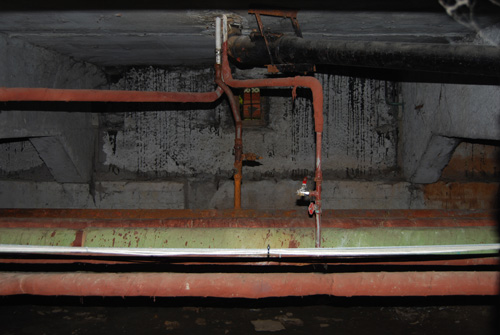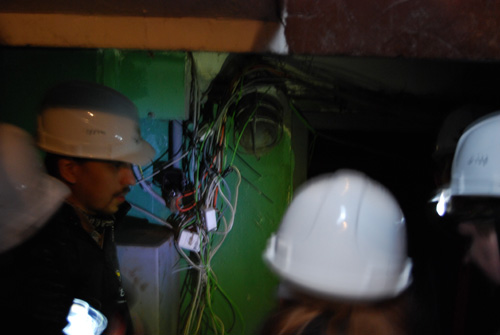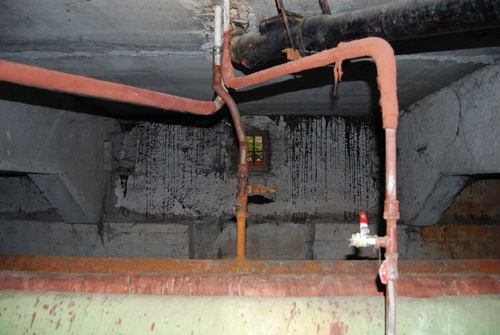The horrors of Petersburg: basements through the eyes of the provider
Surely, the Hub community already knows a lot about internal processes and the activities of Internet providers. Nevertheless, let me tell you about that part of it, the existence of which few people think about. This article will discuss what is happening in the basements of residential buildings and the conditions in which installers and engineers sometimes have to work. Let's see through the eyes of the St. Petersburg "Beeline", which today brought interested journalists and bloggers and showed them their version of the horrors of St. Petersburg - the "wrong side" of the Internet.

')
FTTB technology, according to which Beeline pulls the Internet, implies that the optical cable is brought to a residential building, in which a TKD (shared access point) is located in the attic or in the basement, from where the twisted pair diverges into the subscribers' apartments. Moreover, it is preferable to place it in the attic, because there it is not so damp and usually it is more difficult for an outsider to get there. But in St. Petersburg the situation is different - there are basements in the forced favor, especially in the houses of the old foundation and all the familiar five-story buildings.
The northern capital, as is known, is famous for its eerie, scary basements in the style of Dostoevsky, as well as their regular inhabitants. From here and the first unpleasant problem connected with the maintenance of the equipment in cellars - vandalism. In unfavorable areas of the city (the most disliked area by providers is Nevsky), at least once a week there are complaints to the police about cable cuts or damage to equipment. Subsequently, branded orange wire can be found at fair sales at attractive prices.

Sometimes so-called. “Acts of vandalism” are committed not for the purpose of profit, but from harm. In general, Petersburg is a city of sophisticated subscribers. Having 6-7 providers in the house, people easily change them as soon as more interesting offers appear. Such competition forces providers to resort to less-than-fair competition — cutting each other’s wires, reconnecting subscribers along existing wires of other companies, and so on.
By the way, during the preliminary round of the planned places, the company's employees (as they themselves admitted) were threatened by one of the tenants, who went out with a traumatic weapon and asked the uninvited guests to leave. Therefore, this time the tour was accompanied by apoliceman policeman.
We equipped our guests with raincoats and helmets, and we went to see several typical St. Petersburg basements.

During the excursion they told about the difficulties that the installers faced while working with equipment placed in basements: from problems with access to enclosed spaces, inadequate behavior of tenants and HOAs and up to the need to bail out water and protect themselves from unexpected basement tenants.

However, the basement to the basement is not necessary - in the most ordinary five-story buildings there are examples of how it is, and how the idea should be. After all, a stable connection of subscribers directly depends on the conditions in which the equipment of the provider is operated. But it seems that the desired (it is due) will become valid even oh, how not soon.



')
FTTB technology, according to which Beeline pulls the Internet, implies that the optical cable is brought to a residential building, in which a TKD (shared access point) is located in the attic or in the basement, from where the twisted pair diverges into the subscribers' apartments. Moreover, it is preferable to place it in the attic, because there it is not so damp and usually it is more difficult for an outsider to get there. But in St. Petersburg the situation is different - there are basements in the forced favor, especially in the houses of the old foundation and all the familiar five-story buildings.
The northern capital, as is known, is famous for its eerie, scary basements in the style of Dostoevsky, as well as their regular inhabitants. From here and the first unpleasant problem connected with the maintenance of the equipment in cellars - vandalism. In unfavorable areas of the city (the most disliked area by providers is Nevsky), at least once a week there are complaints to the police about cable cuts or damage to equipment. Subsequently, branded orange wire can be found at fair sales at attractive prices.

Sometimes so-called. “Acts of vandalism” are committed not for the purpose of profit, but from harm. In general, Petersburg is a city of sophisticated subscribers. Having 6-7 providers in the house, people easily change them as soon as more interesting offers appear. Such competition forces providers to resort to less-than-fair competition — cutting each other’s wires, reconnecting subscribers along existing wires of other companies, and so on.
By the way, during the preliminary round of the planned places, the company's employees (as they themselves admitted) were threatened by one of the tenants, who went out with a traumatic weapon and asked the uninvited guests to leave. Therefore, this time the tour was accompanied by a
We equipped our guests with raincoats and helmets, and we went to see several typical St. Petersburg basements.

During the excursion they told about the difficulties that the installers faced while working with equipment placed in basements: from problems with access to enclosed spaces, inadequate behavior of tenants and HOAs and up to the need to bail out water and protect themselves from unexpected basement tenants.

However, the basement to the basement is not necessary - in the most ordinary five-story buildings there are examples of how it is, and how the idea should be. After all, a stable connection of subscribers directly depends on the conditions in which the equipment of the provider is operated. But it seems that the desired (it is due) will become valid even oh, how not soon.


Source: https://habr.com/ru/post/106271/
All Articles